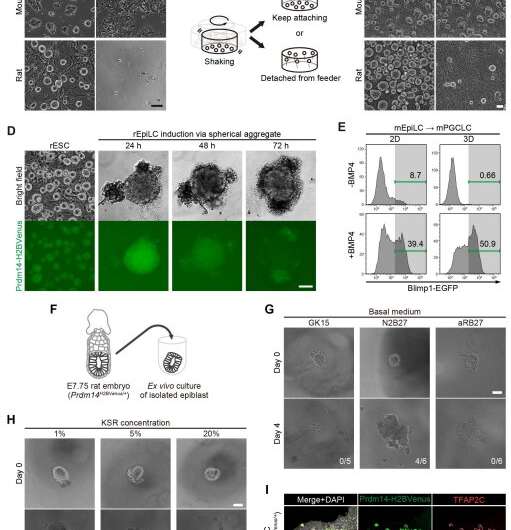Offspring from in vitro–derived germ cells achieved in rats

A team of researchers affiliated with multiple institutions in Japan has produced offspring from in vitro–derived germ cells in rats. In their paper published in the journal Science, the group describes their methodology and explains why they believe their work will lead to a better understanding of in vitro gametogenesis in other species.
In 2011, another team developed a way to reconstitute mouse germ cell specifications in vitro by differentiating mouse pluripotent stem cells into primordial germ-like cells capable of gametogenesis. Since that time, multiple efforts have been mounted to repeat this effort in another species, but until now, all of them have failed, demonstrating how difficult the process can be. More specifically, the earlier research team developed a way to generate mouse sperm-like cells from stem cells, and then used those cells to impregnate a female mouse, who then give birth to healthy pups. In this new effort, the researchers used the earlier study as a template to replicate the process in rats.
The process started with inducing epiblast-like cells in an embryo from rat embryonic stem cells. The resultant cells were then placed in a medium containing a signaling molecule along with other ingredients, which encouraged them to grow into germ-like cells. Next, the cells were cultured along with gonadal somatic cells, a means of simulating a normal maturation process. Once they were mature, the cells were transplanted into the testes of a male rat that had been engineered to have no germ cells. Then they let nature take its course—the cells developed into mature sperm. The researchers then removed sperm samples from the rat and injected them directly into oocytes in a live female rat where they yielded healthy offspring. The researchers note that the offspring grew and were able to reproduce naturally.
The researchers note that after injection of the germ-like cells into the male testes, the males were not able to mate and produce offspring normally because the cells were not mature enough. They suggest more work is required to overcome this problem. But they also suggest that their work provides a path forward for achieving similar results in other species, and perhaps, someday in humans.
Mami Oikawa et al, Functional primordial germ cell–like cells from pluripotent stem cells in rats, Science (2022). DOI: 10.1126/science.abl4412
© 2022 Science X Network
Citation:
Offspring from in vitro–derived germ cells achieved in rats (2022, April 8)
retrieved 8 April 2022
from https://phys.org/news/2022-04-offspring-vitroderived-germ-cells-rats.html
This document is subject to copyright. Apart from any fair dealing for the purpose of private study or research, no
part may be reproduced without the written permission. The content is provided for information purposes only.
For all the latest Science News Click Here
For the latest news and updates, follow us on Google News.

